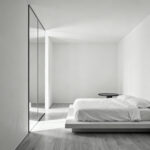Creating a bedroom that truly serves as your personal sanctuary requires more than simply placing furniture around the room. The art of bedroom furniture decorating lies in the thoughtful curation of pieces that not only reflect your aesthetic sensibilities but also enhance your daily rituals and promote genuine rest. When executed with precision, your bedroom becomes a sophisticated retreat that welcomes you each evening and energizes you each morning.
The challenge many face isn’t a lack of beautiful furniture options—it’s understanding how to orchestrate these elements into a cohesive, functional whole. From the foundational decisions of scale and proportion to the nuanced details of lighting and texture, each choice contributes to the overall success of your space. The difference between a room that merely houses your belongings and one that truly nurtures your well-being lies in these carefully considered details.
What follows are twenty-three essential principles that will transform your approach to bedroom furniture decorating. These insights, drawn from years of working with discerning clients, will guide you through every aspect of creating a space that honors both your practical needs and your desire for beauty. Prepare to discover how thoughtful furniture selection and placement can elevate not just your bedroom’s appearance, but your entire living experience.
1. Measure Your Space with Architectural Precision
The foundation of exceptional bedroom furniture decorating begins with meticulous spatial analysis. Professional designers never select a single piece without first understanding the room’s dimensions, architectural quirks, and traffic patterns. This isn’t merely about ensuring furniture fits through doorways—it’s about creating proportional relationships that feel both comfortable and visually satisfying.

Consider the three-dimensional nature of your space, including ceiling height and any architectural details that might influence furniture placement. A room with soaring ceilings can accommodate taller pieces like four-poster beds or armoires, while lower ceilings call for furniture with cleaner, more horizontal lines. Document door swings, window placements, and electrical outlets, as these elements will dictate your furniture arrangement options and influence your lighting strategy.
Essential measurements to record:
- Room length, width, and ceiling height
- Window and door dimensions and swing directions
- Distance between architectural features
- Electrical outlet and switch locations
The investment in precise measurement pays dividends throughout your decorating journey, preventing costly mistakes and ensuring each piece contributes to a harmonious whole.
2. Establish Your Design Philosophy Early
Before considering individual furniture pieces, define the aesthetic narrative you wish to create. This goes beyond selecting a style label—it’s about understanding the emotional quality you want your bedroom to embody. Whether you’re drawn to the serene minimalism of Scandinavian design or the rich textures of traditional English country style, this foundational decision will guide every subsequent choice.

Your design philosophy should reflect not only your aesthetic preferences but also your lifestyle requirements. A busy professional might gravitate toward clean-lined contemporary pieces that promote calm, while someone who works from home might prefer the warmth and character of antique or vintage selections. Consider how your bedroom functions within your daily routine and let this practical understanding inform your stylistic direction.
The craftsmanship behind this collection tells a story of traditional techniques meeting contemporary sensibilities, much like how your personal style should honor both your heritage and your current life.
3. Invest in Your Bed as the Room’s Foundation
The bed commands attention in any bedroom, serving as both the functional centerpiece and the primary design anchor. This isn’t merely about size—it’s about selecting a piece that establishes the room’s character and quality standard. A well-chosen bed frame becomes the foundation upon which all other furniture decisions build, influencing everything from your nightstand selection to your lighting placement.

Consider the bed’s relationship to the room’s architecture. A platform bed with a substantial headboard can ground a room with high ceilings, while a more delicate frame might better suit intimate spaces. The materials you choose—whether rich walnut, brushed steel, or upholstered linen—will echo throughout your other furniture selections, creating the cohesive material palette that distinguishes professionally designed spaces.
Key considerations for bed selection:
- Headboard height relative to ceiling proportions
- Frame width appropriate to room scale
- Material and finish compatibility with other pieces
- Storage integration opportunities
Beyond the obvious placement, consider using this chameleon-like piece to define the room’s entire aesthetic direction.
4. Create a Realistic Investment Strategy
Thoughtful bedroom furniture decorating requires a strategic approach to budget allocation that prioritizes quality where it matters most. Rather than spreading funds evenly across all pieces, invest more heavily in items that affect your daily comfort and will endure years of use. Your mattress and bed frame deserve the largest portion of your budget, followed by storage pieces you’ll interact with daily.

This doesn’t mean compromising on style for secondary pieces—it means being strategic about where to find value. Vintage nightstands can offer superior construction and unique character at a fraction of new retail prices, while splurging on a custom headboard creates a distinctive focal point that elevates the entire room. Consider the cost per year of ownership rather than just the initial purchase price.
The unexpected pairing that always works is combining one or two investment pieces with carefully chosen budget finds, creating a collected-over-time aesthetic that feels both luxurious and authentic.
5. Select Nightstands That Enhance Daily Rituals
Nightstands serve as the bridge between your bed and your daily routines, making their selection crucial to both function and form. These pieces must accommodate your specific bedtime and morning rituals while contributing to the room’s overall aesthetic harmony. Consider not just storage capacity but also the quality of that storage—soft-close drawers and thoughtful interior organization elevate the daily experience.
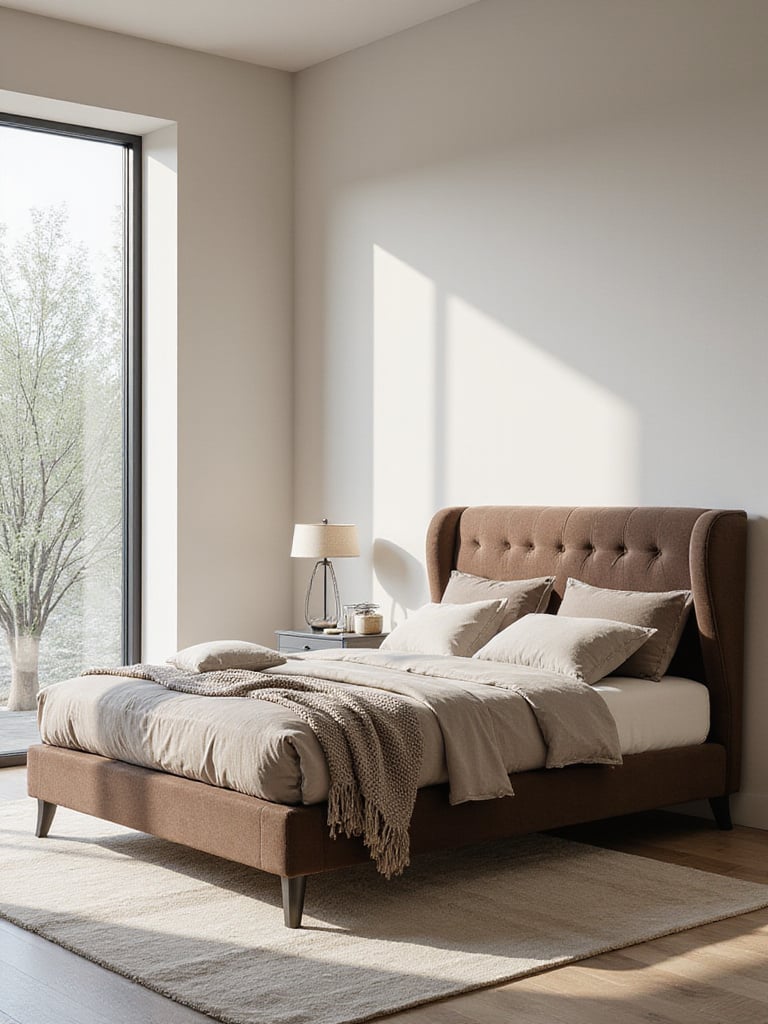
The height relationship between your nightstand and mattress top affects both visual balance and practical comfort. Aim for the nightstand surface to align within two inches of your mattress height, ensuring easy access to essentials without awkward reaching. Scale is equally important—nightstands should feel substantial enough to anchor the bed visually without overwhelming the space.
Functional requirements to consider:
- Drawer depth for books and personal items
- Surface area for bedside essentials
- Cord management for charging devices
- Interior lighting for late-night access
What makes this choice better for your daily experience is the seamless integration of beauty and utility that transforms routine tasks into small moments of pleasure.
6. Design Storage Solutions That Disappear
Effective bedroom storage should be both abundant and invisible, maintaining the serene atmosphere essential to restful sleep. The most successful bedroom furniture decorating incorporates storage seamlessly into the room’s design, avoiding the cluttered appearance that disrupts visual calm. Built-in solutions or furniture with integrated storage maintains clean lines while maximizing capacity.

Consider storage needs holistically—seasonal clothing, linens, personal items, and daily essentials all require different types of accommodation. Vertical storage maximizes space efficiency, while horizontal storage can provide additional surface area for display or daily use. The key is ensuring that storage solutions enhance rather than complicate your daily routines.
The artisans behind these designs began with the understanding that truly luxurious living means never having to compromise between beauty and function.
7. Layer Lighting for Atmospheric Control
Bedroom lighting should be as carefully orchestrated as a fine piece of music, with each layer contributing to the overall composition. Ambient lighting provides the foundation, task lighting serves specific functions, and accent lighting adds drama and visual interest. This layered approach allows you to adjust the room’s mood throughout the day, supporting both active tasks and restful relaxation.

Consider the quality of light as much as its quantity. Warm light temperatures (2700K-3000K) promote relaxation and complement most bedroom color schemes, while cooler temperatures work better for task-oriented activities. Dimming capabilities are essential for creating the gradual transition from day to evening that supports healthy sleep patterns.
Essential lighting layers:
- Ambient: Overhead fixtures or recessed lighting
- Task: Reading lights and vanity illumination
- Accent: Art lighting and decorative fixtures
- Natural: Window treatments that control daylight
As morning light filters through carefully chosen window treatments, the interplay between natural and artificial illumination creates an ever-changing backdrop for your thoughtfully selected furniture.
8. Ground Your Arrangement with Textile Foundation
A well-chosen area rug serves as more than floor covering—it defines the bedroom’s primary zone and provides the foundation that unifies your furniture arrangement. The rug should extend beyond the bed on all sides, creating a generous island that accommodates nightstands and provides a soft landing for bare feet. This textile foundation also contributes significantly to the room’s acoustic comfort.

Size selection requires careful consideration of both the room’s proportions and the furniture arrangement. In most bedrooms, an 8×10 or 9×12 rug provides the generous proportions that create a luxurious feel, while smaller spaces might accommodate a 6×9 rug positioned strategically at the bed’s foot. The rug’s material affects both its longevity and its contribution to the room’s overall texture palette.
The visual weight balances perfectly when your rug choice echoes the room’s primary materials while introducing complementary textures that enrich the sensory experience.
9. Balance Symmetry with Personal Expression
While symmetrical arrangements provide immediate visual calm, the most engaging bedrooms incorporate elements of asymmetry that reflect personal taste and create visual interest. Perfect symmetry can feel sterile—the goal is balanced asymmetry that maintains harmony while allowing for individual expression. This might mean pairing different but complementary nightstands or creating a reading nook on one side of the room.

Consider visual weight rather than exact matching when arranging furniture. A tall, narrow bookshelf can balance a lower, wider dresser when positioned thoughtfully. The key is ensuring that no single area of the room feels visually heavy while others appear sparse. This approach allows you to incorporate meaningful personal pieces that might not have exact matches.
Strategies for balanced asymmetry:
- Vary heights while maintaining similar visual weight
- Use color and texture to create cohesion
- Group smaller items to balance larger pieces
- Incorporate personal collections thoughtfully
The composition comes together when you trust your eye to create relationships between pieces that feel both intentional and effortless.
10. Incorporate Seating That Invites Lingering
A bedroom should offer comfortable seating beyond the bed, creating opportunities for quiet reflection, reading, or intimate conversation. This seating area transforms the bedroom from merely a sleeping space into a true retreat. Whether it’s a comfortable armchair positioned near a window or a bench at the foot of the bed, seating adds both function and visual interest to the room.

The scale and style of your seating should complement your bed and other furniture while serving your specific needs. A chaise lounge might suit a spacious master bedroom, while a compact slipper chair could be perfect for a smaller space. Consider the seating’s relationship to natural light and views—positioning a chair near a window creates a natural reading nook.
The finishing touch that elevates the entire room often comes from this thoughtful addition of seating that invites you to truly inhabit and enjoy your private space.
11. Curate Storage Furniture with Architectural Presence
Dressers, armoires, and other storage pieces should be selected not just for their capacity but for their contribution to the room’s architectural character. These substantial pieces often serve as secondary focal points, and their proportions and detailing can significantly influence the room’s overall sophistication. Look for pieces with interesting hardware, beautiful wood grain, or distinctive silhouettes that add visual interest.

Consider the storage piece’s relationship to the room’s other elements. A tall armoire can balance a low platform bed, while a long, low dresser might complement a bed with a substantial headboard. The finish and hardware should coordinate with other pieces without being overly matched—this creates a collected-over-time aesthetic that feels more sophisticated than a complete bedroom suite.
The unexpected environmental benefit comes from choosing well-made storage pieces that will serve you for decades, reducing the need for replacement and contributing to a more sustainable approach to furnishing.
12. Maximize Vertical Space with Purposeful Design
Bedroom furniture decorating should take advantage of the room’s full height, using vertical space to create storage, display opportunities, and visual interest. Tall bookcases, floor-to-ceiling curtains, and wall-mounted storage can make ceilings appear higher while maximizing the room’s functional capacity. This vertical emphasis also draws the eye upward, creating a sense of spaciousness.

Built-in solutions or furniture that extends toward the ceiling makes the most efficient use of space while maintaining clean lines. Consider the visual weight of tall pieces—they should feel substantial enough to carry their height without appearing top-heavy. Anchoring tall furniture with appropriate lighting or decorative elements helps integrate these pieces into the room’s overall composition.
Vertical design opportunities:
- Floor-to-ceiling built-ins or bookcases
- Tall armoires or wardrobes
- Wall-mounted floating shelves
- Extended-height headboards or wall treatments
The challenge of maximizing storage becomes an opportunity when you approach vertical space as a design element rather than just functional necessity.
13. Choose Multi-Functional Pieces Strategically
In bedroom furniture decorating, pieces that serve multiple purposes provide both practical value and design flexibility. A storage ottoman can serve as seating, a footrest, and a place to store extra linens. A bench at the foot of the bed provides seating while offering additional storage or display space. These multi-functional pieces are particularly valuable in smaller bedrooms where every item must justify its presence.

The key to successfully incorporating multi-functional furniture is ensuring that each function is well-executed. A storage bench should be comfortable for seating and provide meaningful storage capacity. Avoid pieces that compromise too much on one function in service of another—the result is often furniture that doesn’t perform any task particularly well.
The versatility reveals itself when you pair thoughtfully chosen multi-functional pieces with more specialized items, creating a room that adapts to your changing needs throughout the day.
14. Integrate Technology Thoughtfully
Modern bedroom furniture decorating must accommodate technology while maintaining the serene atmosphere essential to good sleep. This means incorporating charging stations, cord management, and device storage in ways that don’t disrupt the room’s aesthetic. Built-in USB ports in nightstands, hidden cable runs, and designated device storage help maintain clean surfaces and organized spaces.

Consider your technology needs realistically—charging stations for phones and tablets, perhaps a discrete television mount, and adequate electrical outlets for various devices. The goal is seamless integration that supports your lifestyle without dominating the room’s design. Wireless charging pads built into nightstand surfaces and furniture with integrated cord management represent the future of bedroom technology integration.
Unlike conventional approaches to bedroom technology, this method reduces visual clutter while ensuring that your devices enhance rather than detract from your rest and relaxation.
15. Select Window Treatments as Furniture Complements
Window treatments should be considered part of your furniture selection process, as they significantly impact the room’s proportions, light quality, and overall aesthetic. The right window treatments can make windows appear larger, ceilings higher, and rooms more luxurious. They also provide essential light control for quality sleep and privacy for intimate spaces.
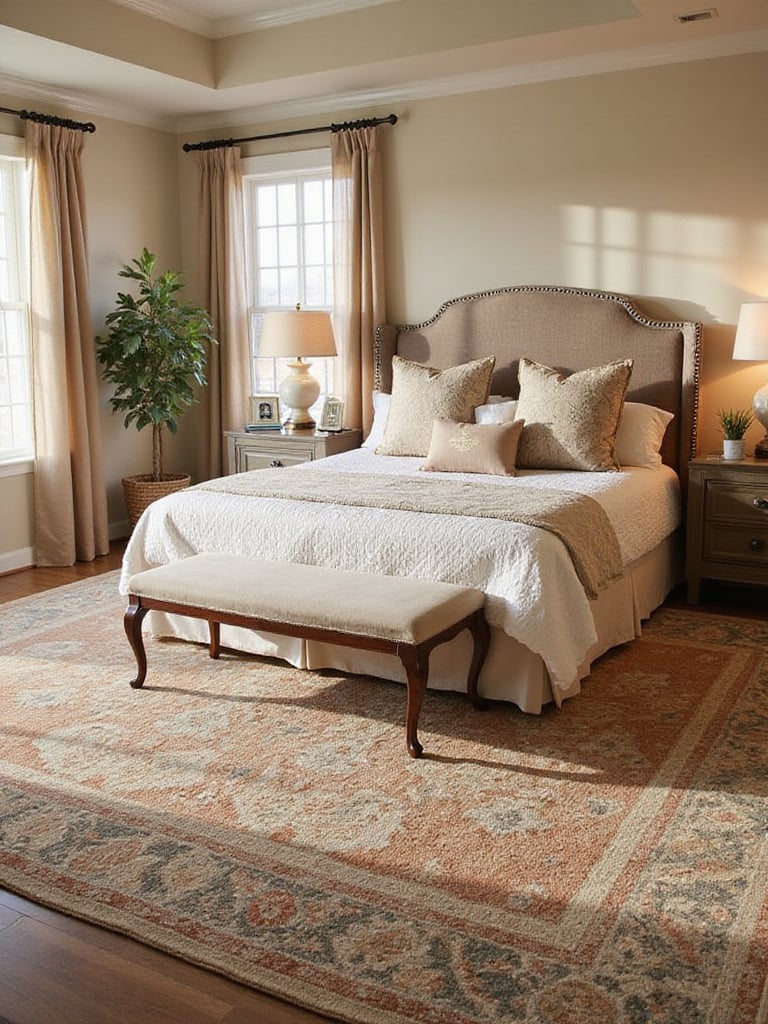
Consider both the functional and aesthetic requirements of your window treatments. Blackout capabilities might be essential for shift workers or light-sensitive sleepers, while others might prioritize the gentle filtering of natural light. The hardware, fabric, and installation height all contribute to the room’s overall sophistication and should coordinate with your furniture selections.
Window treatment considerations:
- Light control requirements for sleep quality
- Privacy needs for ground-floor or close-neighbor situations
- Aesthetic coordination with furniture finishes
- Proportional relationship to room and window size
The mood shifts dramatically when you add window treatments that complement your furniture while providing the light control essential for restful sleep.
16. Create Zones Within Your Bedroom Space
Larger bedrooms benefit from zoning—creating distinct areas for different activities within the single space. A seating area near windows, a vanity or dressing area, and the primary sleeping zone can all coexist when planned thoughtfully. This zoning approach makes large bedrooms feel more intimate while maximizing their functional potential.
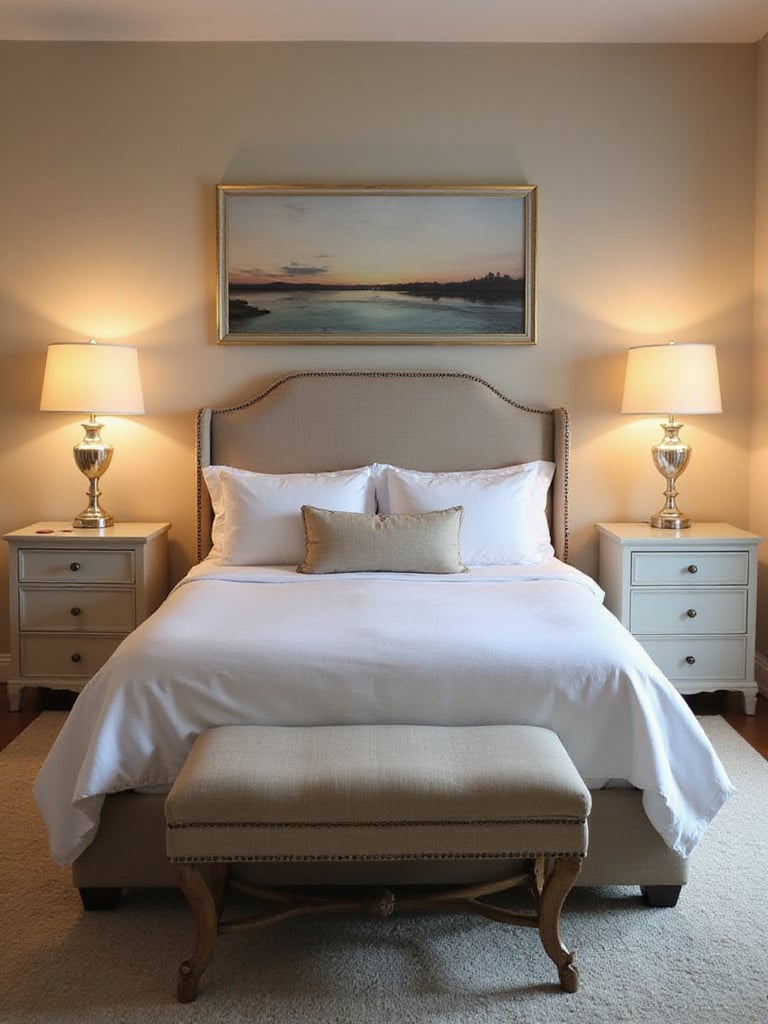
Use furniture placement, area rugs, and lighting to define these zones naturally. A pair of chairs with a small table creates a conversation area, while a beautiful vanity with a mirror and stool establishes a grooming zone. The key is ensuring that each zone feels intentional and contributes to the room’s overall flow rather than fragmenting the space.
The emotional response this approach evokes begins with the understanding that your bedroom can serve multiple aspects of your daily routine while maintaining its primary function as a restful retreat.
17. Incorporate Natural Materials for Warmth
Natural materials bring warmth, texture, and authenticity to bedroom furniture decorating. Wood, stone, natural fibers, and other organic materials create a connection to nature that promotes relaxation and well-being. These materials also age beautifully, developing character over time rather than simply showing wear.

Consider the variety of natural materials available and how they can work together to create a rich, layered environment. Reclaimed wood furniture, stone accent pieces, jute or wool rugs, and linen textiles all contribute to a palette that feels both sophisticated and grounding. The key is balancing these natural elements with more refined pieces to avoid a rustic or overly casual appearance.
The sustainable journey of these materials involves not just their environmental benefits but their ability to create spaces that feel timeless and deeply comfortable.
18. Plan for Seasonal Flexibility
Your bedroom furniture arrangement should accommodate seasonal changes in both function and aesthetics. This might mean choosing pieces that can be easily reconfigured, selecting neutral foundations that work with changing textile accents, or incorporating storage solutions that facilitate seasonal wardrobe transitions. Flexibility in your furniture choices ensures your bedroom remains fresh and functional year-round.
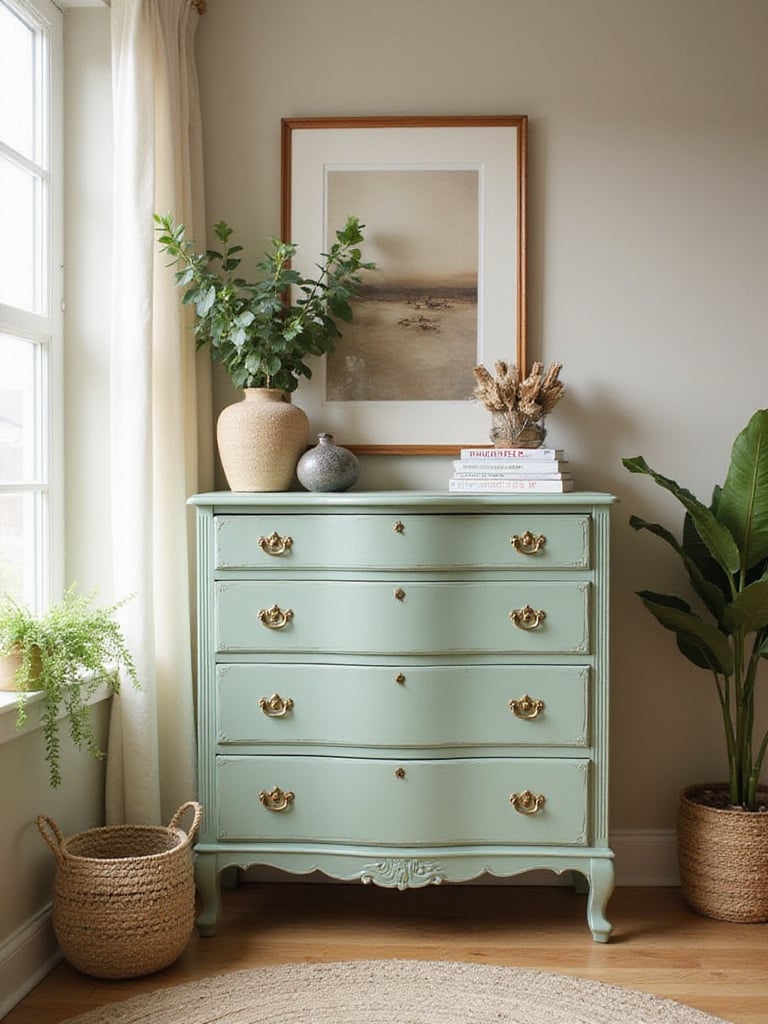
Consider how natural light changes throughout the seasons and how this affects your furniture placement and color choices. A reading chair that receives perfect morning light in winter might be too warm in summer, suggesting the value of lightweight pieces that can be repositioned easily. Seasonal textile changes—heavier fabrics in winter, lighter ones in summer—should be supported by appropriate storage solutions.
Seasonal considerations:
- Furniture positioning relative to changing light patterns
- Storage solutions for seasonal clothing and textiles
- Flexibility for seasonal decorative changes
- Climate control considerations for different materials
The forecast for creating a truly adaptable bedroom lies in choosing foundational pieces that welcome seasonal updates while maintaining their essential character.
19. Invest in Quality Hardware and Details
The hardware on your bedroom furniture—drawer pulls, hinges, knobs, and other functional elements—significantly impacts both the pieces’ longevity and their daily usability. Quality hardware operates smoothly, maintains its finish over time, and contributes to the furniture’s overall aesthetic refinement. This attention to detail distinguishes truly fine furniture from mass-produced alternatives.

Consider upgrading hardware on existing pieces as a cost-effective way to refresh their appearance and improve their function. Soft-close drawer mechanisms, substantial pulls that feel good in the hand, and finishes that coordinate with other room elements all contribute to a more luxurious daily experience. The investment in quality hardware pays dividends in both durability and satisfaction.
The craftsmanship reveals itself in details like smooth-operating drawers, perfectly aligned doors, and hardware that maintains its beauty and function through years of daily use.
20. Consider Scale Relationships Carefully
Every piece of bedroom furniture exists in relationship to every other piece, and understanding these scale relationships is crucial to successful bedroom furniture decorating. A massive bed requires substantial nightstands to maintain visual balance, while delicate furniture pieces need careful positioning to avoid being overwhelmed by larger elements. This isn’t just about matching sizes—it’s about creating proportional harmony.

Consider the room’s architecture when evaluating scale relationships. High ceilings can accommodate taller furniture pieces, while rooms with lower ceilings benefit from furniture with more horizontal emphasis. The goal is creating relationships between pieces that feel natural and comfortable rather than forced or awkward.
The visual weight becomes evident after you live with your furniture choices for a while, making it important to consider not just immediate impact but long-term satisfaction with your selections.
21. Incorporate Personal Collections Thoughtfully
Your bedroom should reflect your personality and interests, but incorporating personal collections requires careful consideration to maintain the serene atmosphere essential to good rest. Books, artwork, photographs, and other meaningful objects can add warmth and character when displayed thoughtfully. The key is curation rather than accumulation—selecting pieces that truly enhance the space.

Consider creating dedicated display areas for collections rather than scattering items throughout the room. A beautiful bookshelf, a gallery wall, or a carefully arranged vignette on a dresser top can showcase your interests while maintaining visual order. The scale and style of display furniture should complement your collections while contributing to the room’s overall aesthetic.
Guidelines for personal collections:
- Group similar items for greater visual impact
- Vary heights and shapes within groupings
- Leave breathing room between displayed items
- Choose display furniture that complements the collection
The cultural heritage preserved in your personal collections becomes part of your bedroom’s unique character when integrated with sensitivity to the space’s primary function.
22. Plan for Adequate Circulation Space
Comfortable movement through your bedroom requires careful attention to circulation patterns and clearance distances. Standard guidelines suggest minimum clearances, but comfortable circulation often requires more generous spacing. Consider not just walking paths but also the space needed to open drawers, make beds, and access storage areas comfortably.

The placement of your largest furniture pieces—particularly the bed—establishes the room’s primary circulation pattern. Secondary furniture should support rather than impede this flow. In smaller bedrooms, every inch of circulation space is precious, making furniture selection and placement even more critical to daily comfort.
The traditional methods used in professional space planning result in bedrooms that feel spacious and comfortable regardless of their actual square footage.
23. Future-Proof Your Furniture Selections
The most successful bedroom furniture decorating considers not just current needs but future requirements as well. This might mean choosing modular pieces that can be reconfigured, selecting neutral finishes that will work with evolving tastes, or investing in quality pieces that will serve you for decades. Future-proofing your bedroom reduces the need for major changes as your life evolves.

Consider how your needs might change over time—career shifts, family changes, aging requirements, or simply evolving aesthetic preferences. Furniture that can adapt to these changes provides better long-term value than pieces that serve only immediate needs. This forward-thinking approach to selection ensures your bedroom remains both beautiful and functional for years to come.
The maker’s journey from traditional craftsmanship to contemporary relevance mirrors your own path in creating a bedroom that honors both your current lifestyle and your future aspirations.
Conclusion
Mastering bedroom furniture decorating requires more than simply selecting beautiful pieces—it demands a thoughtful approach that considers proportion, function, and personal expression in equal measure. The principles outlined here provide a framework for creating bedrooms that serve as true sanctuaries, supporting both rest and the daily rituals that bookend our sleep. When furniture selection is guided by these considerations, the result is a space that feels both professionally designed and deeply personal.
The investment in thoughtful bedroom furniture decorating pays dividends in daily comfort, improved sleep quality, and long-term satisfaction with your living space. Each piece should earn its place through both beauty and function, contributing to an environment that promotes well-being while reflecting your individual aesthetic sensibilities. This approach ensures that your bedroom evolves gracefully with your changing needs while maintaining its essential character.
Your bedroom represents one of your most intimate spaces, deserving the same careful attention you would give to any significant aspect of your life. By applying these principles thoughtfully and consistently, you create not just a beautiful room but a foundation for better living. The transformation begins with understanding that truly exceptional bedroom design honors both the practical and the poetic aspects of daily life.







